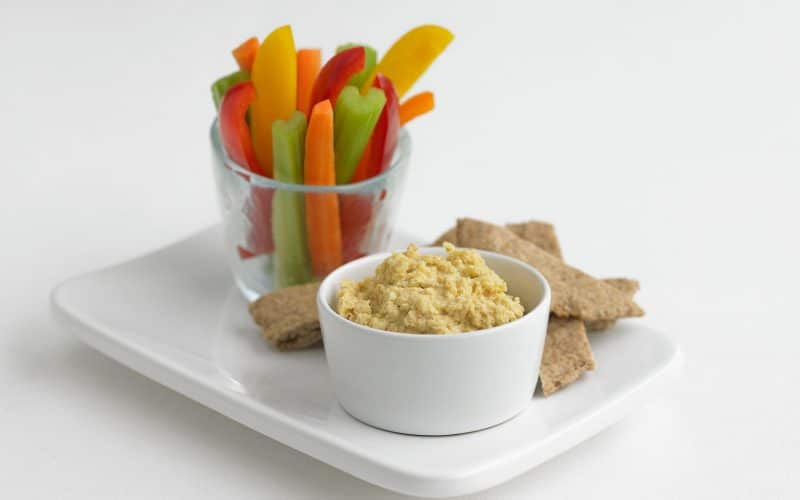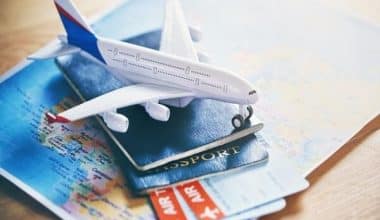A flight, especially a long one, can be a tedious and tiring experience. Some passengers may not enjoy the in-flight meal options. Furthermore, some individuals may have allergies that necessitate avoiding specific foods. Therefore, it is crucial to bring along some snacks in order to give yourself a quick energy boost. But the question is, ” Can You Bring Snacks on a Plane?” The following piece will tell you everything you need to know about bringing and using snacks, food, or drink on an airplane.
Can You Bring Snacks on the Plane?
The answer is yes! According to the TSA’s official website, you can bring solid foods (nuts, fries, chips, and so on) in both checked and carry-on luggage.
However, liquid foods such as beverages, yogurt, and so on, as well as snacks with water as the main ingredient, are a little trickier.
TSA inspectors may require you to separate items from your luggage during airport security if they block the X-ray.
It will be a nightmare if you have to take them out piecemeal and end up in shambles. As a result, you should ensure that your carry-on is already well-organized at home. To expedite the screening process, use clear bags or divide your snacks into small amounts.
TSA Snack Regulations
When it comes to liquid items, you should be aware that they must meet strict specifications when passing through the checkpoint. The 3-1-1 rules are the most noticeable: Your liquids or gels are limited to “3.4 ounces (100ml), and each passenger is only allowed to bring one quart-size bag.”
Snacks Permitted to Be Brought on a Plane
In general, the quantity of snacks, particularly solid food, is not restricted. You can bring any type with any quantity as long as it meets the general rules on carry-on bag dimensions for your luggage’s maximum weight.
Types of Snacks You Can Bring On A Plane
Snacks that have already been packaged
Food packaged ahead of time for convenience and portability is permitted on board. To name a few, chips, nuts, crackers, chocolate bars, cookies, and cereal (granola bars, etc.).
Dried Fruits
Dehydrated snacks, such as raisins, apricots, cranberries, figs, prunes, and so on, are permitted in carry-on bags.
Sweets
Everyone enjoys sweets! They’re tasty, and the high sugar content can help you stay awake during a long flight. They are available in a variety of forms, including candy, pastries, and baked goods. Remember that any food that is solid rather than liquid or semi-liquid is a good choice to bring on board.
Snacks With Specific Regulations
Certain snacks must follow TSA regulations before being packed in your handbag, according to TSA regulations.
Snacks in Canned Form
The TSA says you can bring canned food on a plane, but it must follow the 3-1-1 liquids rules. Although there may be solid foods inside, the liquid is essential for preservation, so only bring them in hand luggage if the liquid is less than 3.4oz.
The issue here is that some food cans always have a thick package. They may not be recognized at the checkpoint, and the inspector may request that you leave them.
As a result, the best option is to pack them in your checked luggage. There are no limits to the number of cans you may bring. Please remember to wrap them in plastic to prevent leakage.
Dips and Spreads
When visiting some of the best places to visit in the world, their cuisine is a fascinating part of the experience, but it may not be to your taste. As a result, you may want to bring some spreads and dips with you on your vacation or trip as a condiment.
Peanut butter, jams, and mayonnaise are essential ingredients for a flavorful sandwich. They are classified as “gel” and must be packed in accordance with the 3-1-1 rules.
Snacks That Are Not Allowed on a Plane
In fact, no snacks are entirely prohibited during a flight because your foods only need to meet some of the airline’s specifications.
Liquids in Excess of 3.4 Ounces (100ML)
This includes beverages, sauces, creams, and other liquid-based foods. Make sure they’re in a quart-sized clear plastic bag and that each container is 3.4 ounces or less. Otherwise, simply place them in checked baggage.
Snacks Made of Fresh Fruit
Bringing fruit on a plane in hand luggage is legal as long as it meets the airline’s size and weight requirements.
Bringing fruits with high water content (such as coconut) or strong odors (such as durian and jackfruit) is still prohibited. They can be packed in your checked luggage.
However, pack them carefully and avoid odors, or your belongings will have an unpleasant odor and may be confiscated. You can bring them on a plane if you put them in a box and seal it tightly.
Furthermore, normal fruits can be transported in large quantities. They should, however, be securely packed in checked baggage.
Keep in mind that some soft fruits, such as strawberries, custard apples, and dragon fruit, should only be brought in small quantities. If you leave them in checked luggage, they may get smashed, and the airline will not be responsible for that.
What Snacks Allowed on an International Flight?
There are no restrictions on what you can or cannot bring on international flights. However, there are restrictions on what you can and cannot bring into the country at some borders. Australia, for example, has strict regulations on what travelers can bring through customs and will confiscate any fresh produce or homemade meals in your luggage.
If you’re traveling internationally, make sure to eat your food in flight to avoid having it confiscated at the border. If you want to bring something in case you get hungry but aren’t sure if you’ll eat it, pack crackers or a protein bar.
Snacks You Shouldn’t Bring on a Plane (Domestic & International)
While technically permitted, as a courtesy to your fellow passengers, you should avoid stinky foods and allergens. Skip messy foods that could easily spill for your own sake.
Avoid bringing the following foods on an airplane:
- Foods that stink, such as tuna
- Peanut butter and other peanut-based snacks are allergens.
- Liquids that are more likely to spill and more difficult to get through security due to size restrictions
A word about yogurt as well. We all know it’s a good last-minute breakfast option when there aren’t many healthy options at the airport, but it has a habit of exploding when opened at high altitudes. If you bring yogurt on your flight, open it slowly to avoid an in-flight disaster. The same can be said for anything else that feels pressed up at altitude.
The best airplane snacks are clean, un-stinky foods that can be eaten at room temperatures, such as dried fruit or a sandwich. If you bring anything from home, make sure it’s TSA-approved and won’t stink up the cabin.
Use this list of healthy, packable airplane snacks and meal ideas if you’re unsure what to bring.
| S. No. | Product | Carry-on Bag | Checked Baggage |
| 1. | Bread | Yes | Yes |
| 2. | Canned Foods | Yes (With instructions) | Yes |
| 3. | Candy | Yes | Yes |
| 4. | Solid Chocolate | Yes | Yes |
| 6. | Crackers | Yes | Yes |
| 7. | Cookies | Yes | Yes |
| 9. | Fresh Eggs | Yes | Yes |
| 10. | Dried Fruits | Yes | Yes |
| 13. | Nuts | Yes | Yes |
| 15. | Pizza | Yes | Yes |
| 16. | Pies and Cakes | Yes | Yes |
| 17. | Sandwiches | Yes | Yes |
| 18. | Snack Bars | Yes | Yes |
| 19. | Snacks | Yes | Yes |
Packing Snacks for an Airplane
Most homemade airplane meals are only as portable as their container. When packing your carefully prepared sandwich, salad, or noodles, use a leak-proof container to keep your food intact.
Vremi Collapsible Food Container
Vremi’s collapsible container line is leak-proof and will keep your food safe during transportation. When you’re done snacking, the container collapses flat, allowing you to store it in your bag without taking up as much space as traditional Tupperware.
Zojirushi Food Jar
Zojirushi, a Japanese company, produces a low-cost but high-quality line of thermoses and food jars designed to keep warm food warm and cold food cold. Use Zojirushi’s food jar to transport your pasta, salads, or snacks if you prefer sturdier Tupperware or want to keep your food hot or cold in transit.
Stasher Bags
To transport your sandwich, pretzels, dried fruit, or any other snack that would normally go into a Ziploc bag, use a reusable silicone bag from Stasher. These bags are even more compact than collapsible Tupperware and can be reused during your trip or on your return flight home. They’ll also help you create less trash while traveling, like Bee’s wrap.
Bee’s Wrap
Unlike foil or plastic wrap, these natural, beeswax-covered wraps can be washed and reused — a plus for eco-conscious travelers looking to reduce the amount of trash they generate on the road. Pack them on the outside or top of your bag to transport sturdier foods like sandwiches or carrot slices.
Humangear Spork
You’ll need a utensil if you’re bringing a dish like noodles or salad. Instead of disposable forks and spoons from airport stores, pack one of Humangear’s small, BPA-free sporks. For an upgrade, get the titanium spork ($14).
Snow Peak Chopsticks
Do you like your noodles with chopsticks? Snow Peak has a pair of portable chopsticks. These chopsticks are made of high-quality stainless steel and bamboo and break in half when not in use to form a full-sized chopstick when assembled. They are more expensive than the $4 spork, but they are extremely well-made and built to last.
Tips for Packing Snacks on a Plane Determine the Appropriate Amount of Snacks
When flying, you can never bring too many snacks. You must be more selective, and the best way to do so is to estimate the flight time, transit time, and so on in order to prepare the appropriate amount of food. This prevents food waste and any unpleasant situations at the airport.
Apply a Packing Cube
If you enjoy a variety of snacks but don’t want to carry a lot of them, use a packing cube instead. It will meet your needs while also keeping your snacks organized.
Make Instant Snacks
The plane or airport will never be as convenient as your own kitchen. As a result, junk food is always the best option for a flight. They are convenient because they do not require reheating or the use of knives, spoons, forks, and so on.
Can I Bring Beverages on the Flight?
You can bring bottled water, juice, soda, and other non-alcoholic drinks in your carry-on bag. Keep in mind that each passenger is only allowed 1,000 ml of liquids, which includes gel cosmetics, shampoo, shower gel, perfume, and drinks.
However, liquid cosmetics and soft drinks can be purchased at duty-free stores in the airport’s secure area and brought on board in any quantity. To avoid breakage, simply close the lids and place them in plastic bags with sealed caps. A strong impact may cause the bottles to break.
Alcoholic beverages are prohibited from being transported on board. However, you are still permitted to bring in checked baggage and hand luggage, subject to several conditions.
Alcohol with a content of 24% to 70% must be kept in the manufacturer’s container, with the original seals and label intact; the bottle’s capacity cannot exceed 5 liters, and no more than 5 liters may be carried by each passenger.
If your drinks contain more than 70% ABV (alcohol by volume), you are not permitted to bring them on a plane under any circumstances.
Can You Bring Snacks on a Plane: Related Articles
- What to Pack for Hawaii: The Ultimate 2023 List
- The Top Best All-Inclusive Family Resorts in Caribbean 2023
- HOW TO TRAVEL CHEAP: 2023 Expert Tips
- TRAVEL MANAGEMENT TOOLS: 2023 Guide
- Where Can You See the Northern Lights?






